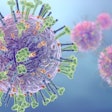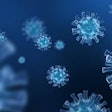
Computed tomography (CT) was able to detect COVID-19, the disease caused by the 2019 novel coronavirus, in individuals with high clinical suspicion of the virus -- even in cases with negative initial DNA tests -- Chinese researchers reported in a study published online February 12 in the journal Radiology.
The group, led by Xingzhi Xie from Central South University in Hunan Province, examined the data of 167 patients suspected of having COVID-19 who underwent a CT exam and DNA testing for the virus, which is known as SARS-CoV-2 or 2019-nCoV. Two thoracic radiologists independently reviewed the CT scans and identified typical imaging findings such as ground-glass opacities, lung consolidation, or both for all of the cases. Clinicians additionally performed DNA analysis of the patients' mouth swab samples using reverse transcription polymerase chain reaction (RT-PCR).
 Chest CT scans of a 60-year-old male with COVID-19 showing multifocal ground-glass opacities and mixed consolidation in the peripheral area of both lungs. DNA tests returned negative for 2019-nCoV until the eight day after presentation. Image courtesy of the RSNA.
Chest CT scans of a 60-year-old male with COVID-19 showing multifocal ground-glass opacities and mixed consolidation in the peripheral area of both lungs. DNA tests returned negative for 2019-nCoV until the eight day after presentation. Image courtesy of the RSNA.After examining the data, the researchers found that the combination of CT and DNA analysis was able to confirm a diagnosis of COVID-19 in the vast majority of the patients (93%). However, in five of the patients (3%), CT scans indicated COVID-19 despite the disease being only weakly positive on initial DNA analysis for one case and entirely ruled out for the other cases.
DNA tests turned out to be negative for the novel coronavirus in multiple cases, contradicting the patients' history of contact with infected individuals and the appearance of common signs suggestive of COVID-19 on their CT scans.
In the case of one 29-year-old man, the initial DNA test was negative for 2019-nCoV and so was the follow-up DNA test performed several days later. His CT scans showed multifocal mixed ground-glass opacities and parenchymal consolidation involving the subpleural regions of both lungs. The patient was not admitted to the hospital for isolated treatment until a third DNA test based on a sample collected eight days after initial presentation turned out positive for the virus.
Current diagnostic criteria regard DNA analysis of swab tests to be a standard and formative assessment for the diagnosis of COVID-19, but the study's results show that DNA tests will occasionally produce false negatives, the authors noted. The limited supply and time-consuming nature of DNA tests, along with their susceptibility to false negatives, underscore the need for improved screening for the early detection of COVID-19 -- a barrier that CT may help resolve.
"In the context of typical clinical presentation and exposure to other individuals with 2019-nCoV, CT features of viral pneumonia may be strongly suspicious for 2019-nCoV infection despite negative RT-PCR results," they concluded. "In these cases, repeat swab testing and patient isolation should be considered."
Chinese officials have decided to expand the diagnostic criteria for COVID-19 to include cases diagnosed based on clinical symptoms and chest CT. As a result, there was a surge in reports for COVID-19, with roughly 15,000 new cases reported between February 12 and 13.



















